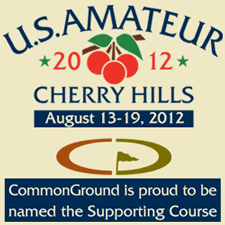This week, Erin Hills in Wisconsin is hosting the USGA’s oldest championship, the U.S. Amateur. Next year in August, it’s Colorado’s turn.
For just the fourth time ever, the U.S. Amateur will be held in the Centennial State, and Colorado has a strong record for producing memorable champions, notably Jack Nicklaus (1959) and Phil Mickelson (1990).
Cherry Hills Country Club, the primary course for next year’s tournament (Aug. 13-19), has a long and storied history of USGA championships, having been home to eight of them, including the 1990 U.S. Amateur.
On the other end of the spectrum as far as hosting USGA events goes is CommonGround Golf Course, which will serve as the second course for the Aug. 13 and 14 stroke-play portion of the tournament. The 312 contestants will play one round each at Cherry Hills and CommonGround, with the top 64 players after 36 holes advancing to match play.
CommonGround, a public course which opened in 2009, is owned and operated by the CGA and CWGA and will be making its USGA championship debut.
While Cherry Hills certainly will be the main showcase for the 2012 U.S. Amateur — the historic course will host all of the match-play portion of the event — the USGA still takes very seriously any venue which plays a significant role in its championships. And it didn’t take long for the powers that be to decide CommonGround rose to the association’s high standards.
Asked what his impression of CommonGround was when he first saw the course, new USGA executive director Mike Davis told COgolf.org, “The impression could not have been better. It’s such a neat story how it’s been built and the very reasonable greens fees there. I think it will be a great partner. I believe it will be an easier test of golf than Cherry Hills — it’s easier to hit fairways (at CommonGround) — but architecturally, it’s outstanding.”
Course designer Tom Doak hit the right notes with his work at CommonGround, but there will be some tweaks to make it stand up to the top amateur golfers in the world.
After lengthy discussions involving the USGA, architect Eric Iverson (part of Doak’s Renaissance Golf Design team) and the CommonGround staff, it was decided to add five tees to the original layout. They’ll be placed at the par-5 third and 18th holes, and the par-4 fourth, fifth and 16th holes.
“Basically what we’re trying to accomplish with the new tees is to preserve the length of the right holes,” said Ed Mate, executive director of the CGA. “We don’t want to make the short holes less short and we want to make sure the long holes stay long.”
CommonGround generally plays to a par-71, but it will be switched to a par-70 for the U.S. Amateur. The 11th hole, now a short par-5, will be made into a par-4, with the tees being moved up. The back portion of the 11th tee will be used to lengthen the par-4 ninth hole.
Moving up the tees on No. 11 “will make it a good short par-4 instead of a really short par-5,” Mate said. “It’ll also bring the lake (to the left of the fairway and near the green) into play.”
Mate fully realizes that given the quality of players who will be competing next year, there will certainly be some low scores shot at CommonGround.
“If the weather is conducive, someone should shoot something (in the low 60s),” Mate said. “That means we’ve done our job if the greens are good and the setup is fair. I would expect someone to shoot 62 because par-5s at this altitude aren’t par-5s, so when you do the math it’s really a par-68, so a 62 — 6 under par — is not phenomenal.”
Davis has set up many courses for USGA championships, but whether CommonGround yields some low scores or not, he’s a big fan of the course.
“When I left (CommonGround after his first visit), I said to Ed, ‘I hope people around Denver realize just how good this course is,'” Davis said. “We’re delighted. In fact, I hope after this one that maybe we can get one of our (U.S.) Public Links Championships played at CommonGround. It would be dynamite to be able to play there.”
Cherry Hills, meanwhile, has already undergone some changes in anticipation of hosting events such as the 2012 U.S. Amateur and the PGA Tour’s BMW Championship in 2014. In late 2008 and early 2009, the course underwent a $7.6 million restoration that added a little more than 300 yards to the maximum length of the layout, which can now reach to 7,462 yards. The project also restored some of the original design elements of the William Flynn layout. Doak and his Renaissance Golf Design team handled those changes.


